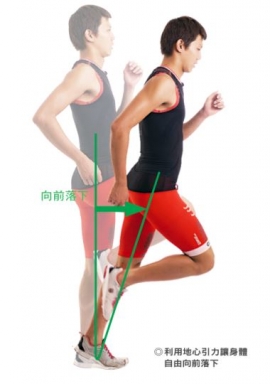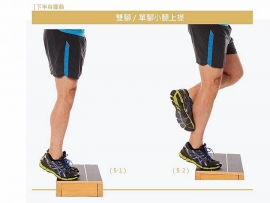直接来看书上的说明:
■ 设计一个核心训练的计划(Designing a Core Training Program )
The goal of core training is to develop optimal levels of neuromuscular efficiency, stability (intervertebral and lumbopelvic stability—local and global stabilization systems), and functional strength (movement system).
(核心训练的目标是去发展肌肉神经效率、稳定度(椎间盘及腰椎骨盆的稳定度-局部及全面的稳定系统)及功能的肌力(动作系统)的最佳水平。)
Neural adaptations become the focus of the program instead of striving for absolute strength gains. Increasing proprioceptive demand by using a multisensory environment and using multiple modalities (balls, bands, and balance equipment) is more important than increasing the external resistance. The quality of movement should be stressed over quantity, and the focus of the program should be on function.
(训练的计划是将焦点放在神经适应而非持续的增加绝对肌力。藉由使用多感官环境及方式(球、弹力带、平衡器材)来增加本体感受的需求比起增加外部的阻力来的更为重要。跟次数来比,应该更强调动作的品质,并且着重在功能上。)
核心训练计划的设计,顺序是非常关键的,必须了解本身或客户的状况,在能完成每阶段的动作,不造成代偿的状况下,才继续往下一阶段进行训练:
1. Intervertebral stability (椎间盘稳定度)
2. Lumbopelvic stability (腰椎骨盆稳定度)
3. Movement efficiency (动作效率)
而书上以NASM提出的OPT模型(稳定度、肌力及爆发力)来进行说明,以有系统而循序渐进的方式来进行设计与训练,一共五个阶段(Phase)。
一. 稳定度(Stabilization)
In core-stabilization training (Phase 1), exercises involve little motion through the spine and pelvis. These exercises are designed to improve neuromuscular efficiency and intervertebral stability, focusing on drawing-in and then bracing during the exercises . The client would traditionally spend 4 weeks at this level of core training.
(在第一阶段核心稳定度的训练,动作上是从嵴椎与骨盆之间进行小范围的移动,改善神经肌肉的效率及 椎间盘的稳定度,将焦点放在动作时的“Drawing-in”及“Bracing”。一般来说,这个阶段的训练需要花4个星期的时间。)
动作的范例有.. [Marching]、[Floor bridge(桥式)]、[Floor prone cobra]及[Prone iso-ab (Plank(棒式)]。
二. 核心力量(Core Strength)
In core-strength training (Phases 2, 3, and 4), the exercises involve more dynamic eccentric and concentric movements of the spine throughout a full range of motion while clients perform the activation techniques learned in core-stabilization training (drawing-in and bracing).
(客户已经可以掌握核心稳定度(Drawing-in及Bracing)的技巧之后,接下来进譬核心力量的训练,以全活动范围的动作并引入更动态的嵴椎离心与向心的动作。)
The specificity, speed, and neural demands are also progressed in this level. Clients would traditionally spend 4 weeks at this level of core training. These exercises are designed to improve dynamic stabilization, concentric strength (force production), eccentric strength (force reduction), and neuromuscular efficiency of the entire kinetic chain.
( 在这个阶段中,动作细腻度、速度及肌肉神经的要求也会提高。客户会花4周的时间在这个阶段的训练中。而这阶段动作的设计会改善束整体动力鍊的动态稳定度、向心肌力(发力)、离心肌力(力量缩减)及肌肉神经的效率。)
动作的范例有..[Ball Crunch]、 [Back Extensions]、[Reverse Crunch]及[Cable Rotations]。
三. 核心爆发力(Core Power)
In core-power training (Phase 5), exercises are designed to improve the rate of force production of the core musculature. These forms of exercise prepare an individual to dynamically stabilize and generate force at more functionally applicable speeds.
(这个阶段动作的设计是用来提升核心肌肉发力的速度。)
动作的范例有..[Rotation Chest Pass]、[Ball medicine ball pullover throw]、[Front medicine ball oblique throw]及[Soccer throw]。
动作上,书上都有图文介绍,山姆伯伯只是上Youtube找了相似的动作。若你不了解动作的话,建议可以翻阅书籍,或是咨询教练。而整个训练的计划,书上有提供以下的表格,大家可以参考一下啰。
先具备稳定度(Stabilization)的能力之中,再进行力量(Strength)的训练,最后再加入爆发力(Power)的训练。有人说,CrossFit不是有药球丢球的动作,一般初学者也可以进行吗?这个动作是复合式的动作,动作的学习过程也是从稳定度、深蹲慢慢开始进行,不会是一开始就直接进到丢球的姿势,以下有一段教学的示范啰。
文章来源:山姆伯伯工作坊




